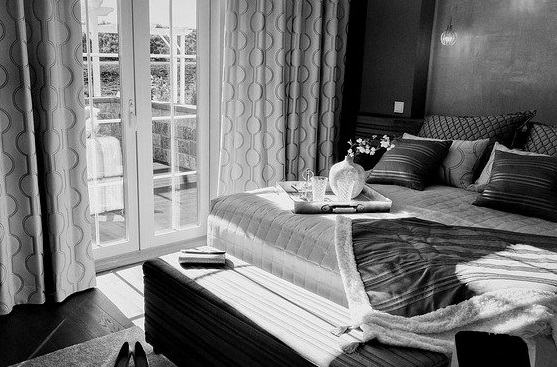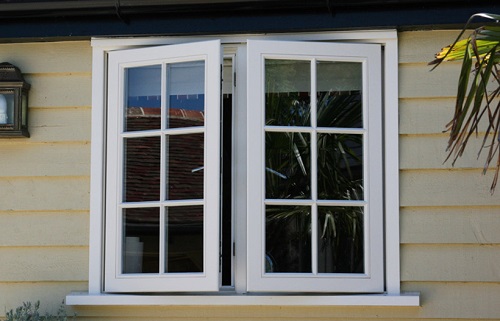Casement

|
Contents |
[edit] Introduction
‘Casement’ is a term usually associated with windows and denotes a window with a glazed 'sash' that is hinged at the sides (side hung), or at the top (top hung) or at the bottom (bottom hung). The parts that open are therefore separate from the frame and are referred to as hinged sashes. This is in contrast to what traditionally would have been called sliding ‘sash windows’, where opening is achieved by a vertically sliding ‘sash’ that moves within the frame.
Casement windows were used before the advent of the sliding sash window which only appeared in the early Georgian period. Before this, casement windows (often with latticed lights) were the predominant window type.
Casement windows usually open from the inside outwards and, depending on the design, can offer full opening for maximum ventilation, as well as allowing a person to lean out. This can also free-up space inside (compared to opening inwards) and may better direct air inwards for ventilation. Typically, if the hinges are on the right of the sash, the locking mechanism will necessarily be on the left, and vice-versa.
In recent years, casement windows in the UK have become more popular than sliding sash windows because they are less complex (no need for hidden cords, pulleys and weights), more economical, have more compact frames, close more tightly, and are easier to manufacture and assemble. Their popularity has spread in part thanks to the marketing activities of replacement window companies which typically replace sliding sash windows with casements.
[edit] Configuration
The frame of a casement window may be divided vertically (with mullions) or horizontally (with transoms) or feature both. The sash or sashes will fit within the frame and be either top-, side or bottom-hinged. Side-hung sashes are usually fitted on butt hinges or easy-clean hinges which allow access to the outside of the glass from the inside. It is quite common to see a central mullion dividing the window frame in two: one half will feature a side-hung sash while the other will have a transom to create a smaller top-hung sash useful for trickle ventilation (see photo).
Top-hung sashes of casement windows are usually secured with a stay while side-hung are secured with a casement stay on the bottom stile which has various adjustable positions and acts to lock the window in the closed position.
Modern sliding sash windows will typically also act as a casement when required so that the glazed part can open inwards for cleaning from the inside.
[edit] Materials
Casement windows are available in a wide choice of materials and styles and usually come as single- double- or triple-glazed. They are available in timber, PVC, aluminium, steel and composite.
Traditional types such as the ‘Crittall’ window were made of galvanised mild steel and were popular for apartment blocks. Single-glazed, they often had a 1930s appearance and had a slimmer framework than timber windows. Being made of steel, they were usually very strong but frequently suffered from cold-bridging while the single-glazing resulted more often than not in condensation in winter, especially if a room was poorly ventilated.
Contemporary aluminium casement windows, typically polyester powder-coated, are much-improved when compared to their earlier counterparts of the 1970s and 1980s and are available as replacements for old wooden or traditional windows.
Recent years have seen the introduction of composite materials which combine wood fibre, mostly reclaimed, with thermoplastic polymer. The resulting composite is claimed to be twice as strong as PVC and offers a thermal transmission that is claimed to be superior to aluminium.
PVC casement windows tend to have a chunkier frame and sashes. When viewed from the outside, it is usually possible to discern the opening sash due to its increased thickness (compared to the frame) which can look unsightly in some configurations. However, modern design and manufacturing techniques produce windows that are very often superior both thermally and acoustically when compared to traditional types and can not easily be disitnguished from painted timber windows.
[edit] Doors

|
Casement is a term that is also applied to doors.
A casement door is similar in concept to a casement window: a hinged single sash (opening door leaf within a frame) or a dual sash to result in what is usually referred to as a ‘French door’. French doors are casement doors which are semi- or fully-glazed and used widely throughout Europe as a means to connect the inside with the outside, often a patio, garden, grounds, deck or balcony.
Casement doors are available in the same materials used for casement windows, i.e wood, PVC, aluminium etc.
[edit] Related articles on Designing Buildings Wiki
- Approved Document K.
- Clerestory.
- Crittall metal windows.
- Domestic windows.
- Dormer window.
- Door.
- Double glazing.
- Easily accessible window.
- External door.
- Fenestration.
- Glass.
- Glazing.
- Jamb.
- Low-e glass.
- Mullion.
- R-value.
- Rooflight.
- Sash.
- Sash windows.
- Secondary glazing.
- Triple glazing.
- Types of door.
- Types of window.
- View.
- Velux window.
- Window.
- Window frame.
Featured articles and news
RTPI leader to become new CIOB Chief Executive Officer
Dr Victoria Hills MRTPI, FICE to take over after Caroline Gumble’s departure.
Social and affordable housing, a long term plan for delivery
The “Delivering a Decade of Renewal for Social and Affordable Housing” strategy sets out future path.
A change to adoptive architecture
Effects of global weather warming on architectural detailing, material choice and human interaction.
The proposed publicly owned and backed subsidiary of Homes England, to facilitate new homes.
How big is the problem and what can we do to mitigate the effects?
Overheating guidance and tools for building designers
A number of cool guides to help with the heat.
The UK's Modern Industrial Strategy: A 10 year plan
Previous consultation criticism, current key elements and general support with some persisting reservations.
Building Safety Regulator reforms
New roles, new staff and a new fast track service pave the way for a single construction regulator.
Architectural Technologist CPDs and Communications
CIAT CPD… and how you can do it!
Cooling centres and cool spaces
Managing extreme heat in cities by directing the public to places for heat stress relief and water sources.
Winter gardens: A brief history and warm variations
Extending the season with glass in different forms and terms.
Restoring Great Yarmouth's Winter Gardens
Transforming one of the least sustainable constructions imaginable.
Construction Skills Mission Board launch sector drive
Newly formed government and industry collaboration set strategy for recruiting an additional 100,000 construction workers a year.
New Architects Code comes into effect in September 2025
ARB Architects Code of Conduct and Practice available with ongoing consultation regarding guidance.
Welsh Skills Body (Medr) launches ambitious plan
The new skills body brings together funding and regulation of tertiary education and research for the devolved nation.
Paul Gandy FCIOB announced as next CIOB President
Former Tilbury Douglas CEO takes helm.
UK Infrastructure: A 10 Year Strategy. In brief with reactions
With the National Infrastructure and Service Transformation Authority (NISTA).























